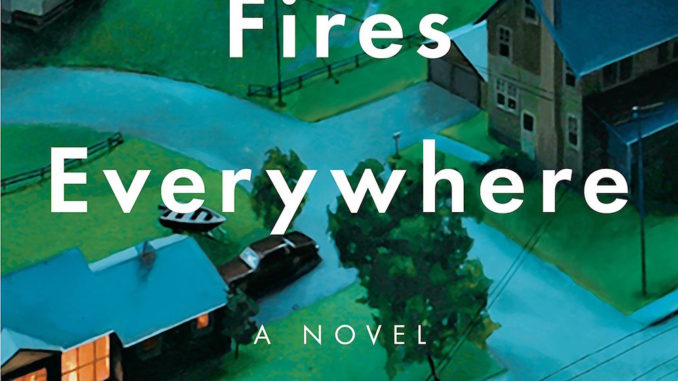
By Audrey Gutierrez
Already, “Little Fire Everywhere,” Celeste Ng’s new novel, has a TV deal with producers/actresses Kerry Washington and Reese Witherspoon, is several prominent book clubs’ pick of the months, and has been reviewed by The New York Times. What makes it so special? By exploring issues such as racial tension and changing familial relationships through focus on multiple moving characters and storylines, the new novel makes it more publically successful than Ng’s previous works. The only problem is that some of the parts aren’t as engaging as others.
“Little Fires Everywhere” is set in Ng’s hometown of Shaker Heights, Ohio, in the 90’s. Shaker Heights is a strict suburban community where the majority of residents are white. Its motto is “most communities just happen; the best are planned.” No one follows this mindset more so than Elena Richardson, a journalist who lost her rebellious streak after college and now writes for the town’s fluff-filled newspaper. When Elena’s house burns down at the start of the novel, she immediately knows it was her youngest daughter, Isabelle. By answering the question of who did it at the start of the novel, Ng leaves readers to find out why she did it. She does this by examining the conflict of two families, the Richardsons and the Warrens, a few months before the fire.
The Warrens are newcomers to Shaker Heights. Unlike the Richardsons, they are an artistic mother and daughter, Mia and Pearl. The purpose of Pearl’s character is to find out who her father is and to participate in a love triangle with two of the Richardson boys. The love triangle between the bookish son, the athletic son, and the quiet, smart girl feels overdone and forced, especially amongst the seriousness of the other events in the novel. Ng spends a lot of time trying to highlight the differences between the two families through dynamics like the one between Pearl and the Richardson boys or the Richardson daughter, Isabelle, and her vehement admiration of Mia Warren. She spends a chapter focusing on Mia’s photography, something which is interesting, but nowhere near as engaging as the custody trial. The custody trial poses the Richardsons and Warrens on either ends of each other when family friends and legal clients of the Richardsons adopt a Chinese-American baby and the mother, a friend of Mia Warren’s, Bo Chow, attempts to reclaim her.
This book poses a few important questions in regards to this trial which turns Shakers Heights into a media circus. Does the adoption of minorities by white parents prevent these children from remaining connected to their cultural backgrounds? One way in which this question is explored is through the remaining of the baby, whose real name is May Ling Chow, as Mirabelle McCullough. Whenever she is introduced in the future, she will not be aligned with Chinese culture. Instead, the McCulloughs have ensured that she identifies as one of them. The McCulloughs give the baby dolls that look nothing like her. They’re tall and blonde, leaving her no way to identify with someone that looks like her in both her community or her toys. If given the option, is it better for minority children from low income families to remain as they are or be raised by people who have nothing in common with them? One argument shown between a prominent African-American couple in Shaker Heights, the Averys, presents the husband arguing that the baby is being given a better chance of success in this rich, white household, but the wife blames the problem on the biased system and says one saved baby won’t save the others. She also says that a mother belongs with its child. This is an idea reiterated throughout the course of the book, but to answer it, one has to consider the qualifications of motherhood.
As Ng writes, “what made someone a mother? Was it biology alone, or was it love?” It is obvious that both Bo Chow and Mrs. McCullough love the child, but by staying with Mrs. McCullough, May will lose access to different parts of her culture. By staying with Bo Chow, she will be less financially stable. The two can both be mothers to May Ling Chow in regards to their amount of love for her, but with either, sacrifices will be made. The question the book asks readers to consider is what is fair to deny a child in adoptions between people of different races.
The fire is introduced as the main issue of the book, but it feels like it takes away from the focus of the trial. Two-thirds of the book is focused on it and the personal dramas of the Richardsons and Warrens. The fire is set by someone on the outskirts of the trial, Isabelle Richardson, and her reasons for burning down the house are more personal than they are substantial. “Little Fires Everywhere” is well-written, but too often it feels as if Ng is trying to tell you what to feel in moments where characters do things that they don’t have enough motivation to. If you plan on reading a book by Celeste Ng, “Everything I Never Told You” is the better option, though it might not be as acclaimed as this one.
Subscribe to the Mossy Log Newsletter
Stay up to date with the goings-on at Lewis & Clark! Get the top stories or your favorite section delivered to your inbox whenever we release a new issue.

Leave a Reply